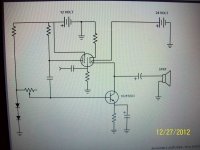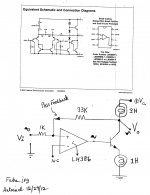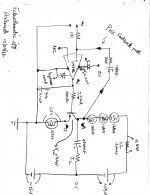Member
Joined 2009
Paid Member
Electrons boil off the Wolfram wire, form a mobile sheath/cloud around it, and contribute to its classical solid state resistance. A hypothesis maybe that hot electrons may impart a "better" sound than cold ones meandering through a luke warm wirewound or Carbon composition power resistor.
I think you'd better lay off the egg nog :
A hypothesis maybe that hot electrons may
impart a "better" sound than cold ones meandering through a luke warm
wirewound or Carbon composition power resistor.
The light bulb definitely imparts one characteristic - in the midrange the
filament has a resonance which creates a slight bump to the output.
Interestingly, many years ago I was puzzled to see a Julian Hirsch
(Stereo Review for you tadpoles among us) review in which the Levinson
ML-3 amplifier had a bump-up in the midrange. Now I realize that perhaps
they were trying to simulate the light bulb.
I like the lightbulbs. They are cheap and contribute an organic quality to the
whole enterprise.
Thank you Mr. Pass for the information above, and thank you Bigun for responding. I'll have egg nog tomorrow. What if the incandescent light load [wrenchone's or that of Rothacher's V.1 SIT amp] is the filament of a vacuum tube; for example KT88? Its cathode heater uses 1.6 A, and the tube has a maximum plate current of 140 mA. In a next step, I am in a position to bias this tube normally [wrenchone's +45 Vdc is/maybe ground for tube]. Apply a grid signal that is either in and or out of phase with that at the amp's input. Will this hypothetical setup work, and further influence the sonics of the parent amp [tube not biased]?The light bulb definitely imparts one characteristic - in the midrange the
filament has a resonance which creates a slight bump to the output.
Interestingly, many years ago I was puzzled to see a Julian Hirsch
(Stereo Review for you tadpoles among us) review in which the Levinson
ML-3 amplifier had a bump-up in the midrange. Now I realize that perhaps
they were trying to simulate the light bulb.
I like the lightbulbs. They are cheap and contribute an organic quality to the
whole enterprise.

Thank you Mr. Pass. The heater voltage for KT88 is 6.3V pushing 1.6 A. By contrast, the dual heaters in 12AX7 connected in parallel require 6.3 V which pushes ~ 0.3 A to give a heater resistance of ~20 Ohms. Will a signal on its grid or cathode modulate heater current; due to proximity; also noting that the maximum sum current of its plates add up to a meager 2.4 mA? If this is possible, then one has an Active and Functional incandescent load.I suppose it depends on the actual resistance of the heater. You are looking
for something on the order of 20 ohms.

Lucky you; I only have four 12AX7s. I'll work with them this week and share the findings. Happy holidays.I have been thinking about using tube heaters as well! I have a very very large pile of non usable for audio tubes that need uses!
I checked out my hysteretic buck converter last weekend (I started up the circuit cold into a current source load and checked the inductor current vs. output voltage), and the performance (to me) was not acceptable. I basically want an ironclad current limit, but that's not happening, possibly because the hysteresis I'm programming is too small and the comparator is too slow. I have a possible solution for this, but before I discard the old design, I'd like to try a dodge where the programmed hysteresis is adaptive. In specific, I'd like to program a lot of hysteresis in cases where the input to output voltage difference is high - in other words, startup and overload/short circuit. In these cases, the output inductor of the regulator needs some time to discharge before the next switching cycle so that the output current doesn't ramp up out of control. I have a way to do this that I can hack into the existing circuit, and I might try it this weekend. It would be nice to get an acceptable solution with a crappy comparator like the LM393.
This is turning out to be interesting in the Chinese meaning of the term (may you live in interesting times...). There are no obvious single chip solutions I can apply to this problem, so it's up to me...
This is turning out to be interesting in the Chinese meaning of the term (may you live in interesting times...). There are no obvious single chip solutions I can apply to this problem, so it's up to me...
This must be contagious
I have been working on this for a few weeks. The diagram isn't labeled for parts values but the tube is a 12K5 space charge tetrode and the setup is very straightforward. The sound was very good I thought, but this one was dismantled and another constructed in its place utilizing a 15CW5 and MJ15003 with a single 30 volt supply. When biased for 1/2 supply at midpoint you get the requisite 300 ma through the filament (heater). The sound is very good (to me). I worried about crazy feedback and/or regeneration effects possibly showing up but I can't recognize any sonic problems with this. Apologies to Pete Millett and his "Starving Student" headphone circuit. This was not intended to be a ripoff, I was just curious one night and it happened to work, before I stumbled on his circuit. I was looking for something "hybrid" for a table radio project that is ongoing. There is hardly anything new under the sun. Just posted this to confirm it does work. And works well IMHO.
Cheers,
Terry
I have been thinking about using tube heaters as well!
I have been working on this for a few weeks. The diagram isn't labeled for parts values but the tube is a 12K5 space charge tetrode and the setup is very straightforward. The sound was very good I thought, but this one was dismantled and another constructed in its place utilizing a 15CW5 and MJ15003 with a single 30 volt supply. When biased for 1/2 supply at midpoint you get the requisite 300 ma through the filament (heater). The sound is very good (to me). I worried about crazy feedback and/or regeneration effects possibly showing up but I can't recognize any sonic problems with this. Apologies to Pete Millett and his "Starving Student" headphone circuit. This was not intended to be a ripoff, I was just curious one night and it happened to work, before I stumbled on his circuit. I was looking for something "hybrid" for a table radio project that is ongoing. There is hardly anything new under the sun. Just posted this to confirm it does work. And works well IMHO.
Cheers,
Terry
Attachments
Terry, It is contagious, and love the circuit you showed. I am also working on a circuit which I'll share ASAP. Kind regards.I have been working on this for a few weeks. The diagram isn't labeled for parts values but the tube is a 12K5 space charge tetrode and the setup is very straightforward. The sound was very good I thought, but this one was dismantled and another constructed in its place utilizing a 15CW5 and MJ15003 with a single 30 volt supply. When biased for 1/2 supply at midpoint you get the requisite 300 ma through the filament (heater). The sound is very good (to me). I worried about crazy feedback and/or regeneration effects possibly showing up but I can't recognize any sonic problems with this. Apologies to Pete Millett and his "Starving Student" headphone circuit. This was not intended to be a ripoff, I was just curious one night and it happened to work, before I stumbled on his circuit. I was looking for something "hybrid" for a table radio project that is ongoing. There is hardly anything new under the sun. Just posted this to confirm it does work. And works well IMHO.
Cheers,
Terry
Faking wrenchone's L'Fake amp ...maybe
Hello wrenchone. L'Fake's Fake was put together with only bjts, operates in Class A and is low power; but has the key elements you taught in post #14, and more as bonus. The attached jpg shows its design components:
Best regards.
Hello wrenchone. L'Fake's Fake was put together with only bjts, operates in Class A and is low power; but has the key elements you taught in post #14, and more as bonus. The attached jpg shows its design components:
- The simplified schematic of the chip amp LM386 by Texas Instruments.
- The Fake's simplified schematic based on LM386, a power NPN, and incandescent bulbs using the heaters of the vacuum tube type 12AX7.
- Three 12AX7 heaters [3H] connected in series as collector load to the power NPN.
- One 12AX7 heater [1H] connected as emitter resistor
- Idle current through the power NPN is 0.3 Amperes; because the tube heaters are connected for 6.3 V service.
- Pass Feedback from the power output port [Vo] to the non-inverting input of LM386 which is a summing junction of two out of phase signals.
Best regards.
Attachments
Faking wrenchone's L'Fake Amp..maybe
Here is a more detailed schematic of the subject in the attached jpg. Please note the following:
Here is a more detailed schematic of the subject in the attached jpg. Please note the following:
- A +/- 15 VDC dual power supply was used.
- The negative rail is signal ground; because the inputs of LM386 are referenced to it and not to the center tap [0 VDC; see its schematic by TI].
- The center tap of the power supply is 0VDC. It is the V+ power rail to LM386. I subtracted ~1.8 VDC from ~15 VDC by using the series connected LED as insurance so as not to exceed its rail rating of +15 VDC.
- LM386 is configured as recommended by TI [10 uF bypass cap, Zobel].
- Note the sense resistor [1 Ohm ] in series with the +15 VDC rail. The voltage drop across it is ~0.3 VDC or the idle current flowing through the output circuit is 0.3 A.
- Note the blocking electrolytic capacitors for the path of Pass Feedback, and power output
Attachments
Interesting digressions
.....we have here, similar but not in sync with Wrenchone's design....perhaps Antoinel, it is appropriate to start another thread with your design. Yours and my circuits are different creatures than the OP's. Just a thought. If you open another thread I would be glad to chime in.
Cheers,
Terry
.....we have here, similar but not in sync with Wrenchone's design....perhaps Antoinel, it is appropriate to start another thread with your design. Yours and my circuits are different creatures than the OP's. Just a thought. If you open another thread I would be glad to chime in.
Cheers,
Terry
I gave the nomenclature "Pass Feedback" to a specific type of overall feedback which emanates from a high impedance port [collector] to a summing junction which in this case is phase non-inverting. It is clearly different from that used in an inverting Op Amp; or a non-inverting power amp whereby the origin of the feedback [Black] is a voltage source or low impedance port. In semiconductor circuits, Pass Feedback [ also in L'Fake amp by wrenchone] is like that of Schade Feedback in vacuum tubes. Schade Feedback is not called Black Feedback!Antoinel
that Pass Feedback path is nothing else than overall feedback , common arrangement for inverting gain stage
Last edited:
Terry, thank you for your recommendation. I'll start a fresh thread......we have here, similar but not in sync with Wrenchone's design....perhaps Antoinel, it is appropriate to start another thread with your design. Yours and my circuits are different creatures than the OP's. Just a thought. If you open another thread I would be glad to chime in.
Cheers,
Terry
Other Applications of Vacuum Tubes
Kind regards.
The new Topic or Thread is in the Everything Else Forum. It is entitled "Other Applications of Vacuum Tubes"......we have here, similar but not in sync with Wrenchone's design....perhaps Antoinel, it is appropriate to start another thread with your design. Yours and my circuits are different creatures than the OP's. Just a thought. If you open another thread I would be glad to chime in.
Cheers,
Terry
Kind regards.
I was up at the hardware store getting a replacement flood light, and picked up a couple of pairs of 300W linear quartz-iodine lamps (Feit Electric again, cheap and cheerful) to try out as possible loads for L'fake Lite. The 300W linear bulbs bias up much the same as the 300W bulbs that started this thread, such that a pair in parallel will be needed, just as with the 300W standard bulbs. They glow brighter than the old bulbs for the same current, for those who care. Next time I'm shopping, I'll pick up some higher wattage bulbs, as I'd like to make do with just one bulb per channel. The hard part will be picking up the contacts for properly mounting the linear bulbs. A China source on Ebay sells them, but I'd like to find someone local.
This is an interesting application which generates electrically neutral Iodine free radicals [unpaired electrons]. There is a probability to detect a sonic difference between your standard incandescent [baseline] and this halogen lightbulb [a radical change!]?I was up at the hardware store getting a replacement flood light, and picked up a couple of pairs of 300W linear quartz-iodine lamps (Feit Electric again, cheap and cheerful) to try out as possible loads for L'fake Lite. The 300W linear bulbs bias up much the same as the 300W bulbs that started this thread, such that a pair in parallel will be needed, just as with the 300W standard bulbs. They glow brighter than the old bulbs for the same current, for those who care. Next time I'm shopping, I'll pick up some higher wattage bulbs, as I'd like to make do with just one bulb per channel. The hard part will be picking up the contacts for properly mounting the linear bulbs. A China source on Ebay sells them, but I'd like to find someone local.
- Status
- This old topic is closed. If you want to reopen this topic, contact a moderator using the "Report Post" button.
- Home
- Amplifiers
- Pass Labs
- L'Fake - A Cheap- A** Expedient to Replace the Elusive SIT



